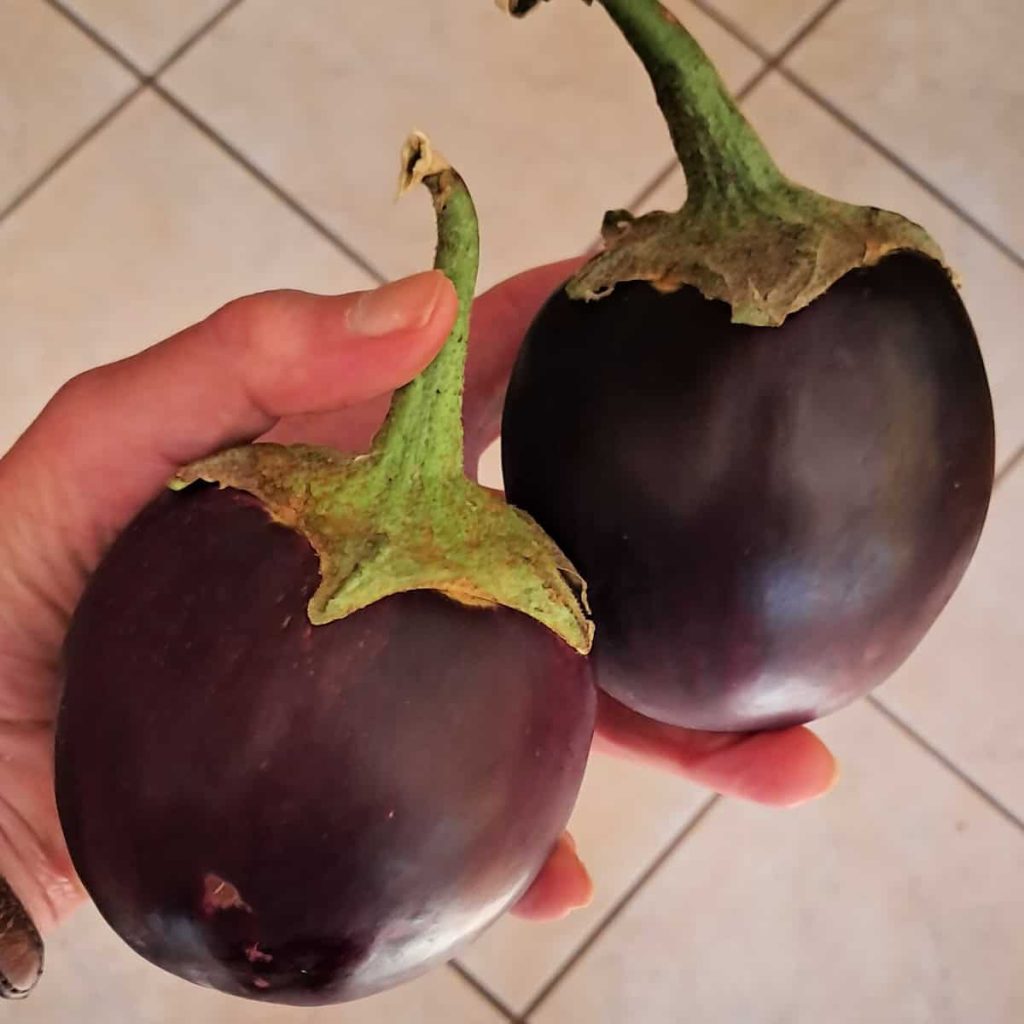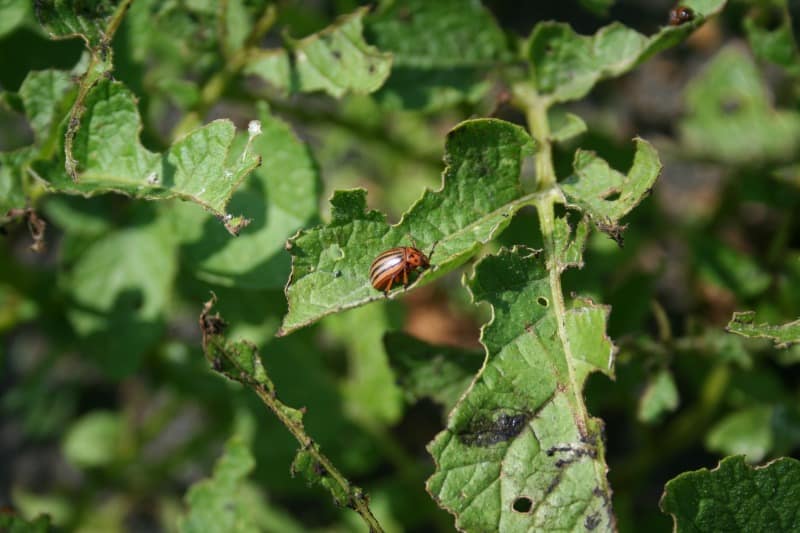Growing eggplant (a small garden devoted to fresh, seasonal edibles) is relatively easy in zone 7, where I garden, but combating the bugs is another story. Growing epplant in pots, containers, raised beds, or garden soil is all possible if you are willing to go the extra mile to control its nemesis, the Colorado potato beetle.
Here I provide a plant profile for growing eggplant, followed by interesting eggplant varieties to try, and some personal, firsthand experience with insect pests. Lastly, I include some recipes to try and resources to help you grow great eggplants.
Plant Profile: Eggplant
Botanical name: Solanum melongena
Light requirements: Eggplant needs full sun to flourish. Aim for at least 6 to 8 hours of direct sunlight each day.
Soil requirements: It prefers well-draining, fertile soil rich in organic matter. A slightly acidic to neutral pH between 5.8 and 6.5 is ideal.
Water requirements: Keep the soil consistently moist but not soggy. Deep watering once or twice a week is often enough, depending on the weather. Avoid wetting the leaves to reduce the risk of fungal diseases.
Fertilizer requirements: Feed eggplant with a balanced fertilizer (e.g., 10-10-10) at planting time. Once flowering begins, switch to a fertilizer higher in phosphorus and potassium to support fruit development. Compost or well-rotted manure can also be mixed into the soil beforehand to boost nutrition.

How to Grow Eggplant Successfully
I’ve grown eggplant in pots and containers as well as in my raised bed vegetable garden here at Seven Oaks Farm, the name of the farm where Home Garden Joy is based.
You can grow eggplant from seeds or purchase eggplant seedlings at the garden center. If you grow eggplant from seeds, start it indoors under grow lights at least 8-12 weeks before you intend to plant it outside. It should not be moved outdoors until all danger of frost is past; it is susceptible to cold and can’t tolerate cold nights or cold temperatures.
A heating mat placed under the seed starting tray will warm the soil and encourage good germination rates. Heating mats are special heating pads made to be used with plants (and the moisture conditions inherent in gardening). You can buy them from your local garden center or Amazon. I’ll put links into the article to some that I like. Do not use a heating pad or anything not made for seed starting – a heating pad made to be used with people is very different from a seed heating mat, and using a heating pad with seeds can start a fire. Don’t do it!
When seedlings have at least two sets of leaves, harden them off by moving them outdoors on warm, sunny days. Take the trays back indoors at night until nighttime temperatures are above 60 degrees F.
Can You Grow Eggplant In Containers?
Yes! It does quite well in pots and containers. Use the largest planter you can find and place an eggplant seedling in the center. Make sure there are drainage holes in the bottom of the container so excess water can run off.
Eggplant does not require supports or stakes. Fertilize regularly, either top dressing with compost or with 10-10-10. Eggplants are heavy feeders and produce more with good soil fertility.
Eggplant Pests: The Colorado Potato Beetle
I mentioned that I’ve grown eggplant in the past. I’ve grown them in containers and pots in my Long Island, New York, apartment, and I grew them here in raised beds. I stopped growing them a few years ago (the ones in the picture I bought at the local farmer’s market) because the Colorado potato beetle infestation was so bad.

What Is the Colorado Potato Beetle?
The Colorado potato beetle, Leptinotarsa decemlineata, is a notorious pest that feeds on plants in the nightshade family, including eggplants. Both the larvae and adult beetles consume the foliage, often starting at the top of the plant and working downward. Their feeding can lead to significant defoliation, which weakens the plant and reduces fruit yield. Eggplants are particularly vulnerable because they are less tolerant of leaf loss compared to other crops like potatoes. The beetle’s preference for solanaceous plants stems from its evolutionary adaptation to these hosts, and once established, populations tend to grow annually, making management increasingly difficult.
How Can I Control Colorado Potato Beetle on Eggplant Organically?
Controlling Colorado potato beetles on eggplant organically involves a mix of cultural, mechanical, and biological strategies. Start by rotating crops and avoiding planting eggplant near previous Solanaceae crops to disrupt the beetle’s life cycle. Use floating row covers early in the season to prevent adult beetles from accessing plants, and apply straw mulch to deter movement and attract natural predators. Handpick beetles, larvae, and eggs regularly, dropping them into soapy water. Introduce beneficial insects like ladybugs and ground beetles, or plant nectar-rich flowers to attract them. For biological control, apply Bacillus thuringiensis or neem oil during early larval stages for best results. Combining these methods consistently can significantly reduce beetle populations without synthetic chemicals.
Eggplant Varieties to Grow at Home
If you thought all eggplants are alike, think again! The small round ones I picked up at the local Pamplin area Farmer’s Market differ from the traditional, oblong ones; there are long, slender Japanese varieties, even white skinned eggplant! Here’s a list to try – you can find seeds for each from many online retailers and Amazon.
Italian Varieties
- Rosa Bianca – Round, lavender and white; creamy texture and mild flavor
- Traviata – Oblong, deep purple; classic bell shape and high-yielding
- Barbarella – Round, dark purple with white halo; deeply pleated skin
- Paloma – Egg-shaped, white; sweet taste and creamy flesh
- Prosperosa – Round, violet with ribbing; ideal for stuffing
- Aretussa – Cylindrical, white; tender skin and mild flavor
- Beatrice – Egg-shaped, violet; early maturing, and creamy texture
- Violetta di Firenze – Round, purple with white streaks; heirloom with meaty flesh
Japanese Varieties
- Ichiban – Slender, deep purple; thin skin and mild flavor
- Shikou – Oblong, glossy dark purple; nutty taste and few seeds
- Millionaire – Cylindrical, black-purple; early maturing and tender flesh
- Ping Tung Long – Long and thin, bright purple; sweet and seedless
- Japanese Pickling – Very long, bright purple; ideal for pickling
- Shoya Long – Extra-long, dark purple; popular in Japan
- Black Egg – Round, nearly black; compact and great for containers
- Fengyuan Purple – Cylindrical, bright purple; creamy and mild
These varieties offer a wide range of culinary possibilities—from grilling and roasting to pickling and stuffing.
Eggplant Recipes to Try
I’ve made eggplant in many different ways. This weekend, I made stuffed eggplant. It came out great. Here is the recipe and a picture of my version. I used a food processor to chop the ingredients since I do not have the patience to dice anything fine. Stuffed Baby Eggplants


My recipe for Grilled Eggplant is a family favorite.
Here’s a recipe for Baked Eggplant without bread crumbs that’s a little lighter than other recipes, from my friend Marye @Restless Chipotle.
Eggplant Seeds, Heating Mats, and More
Home Garden Joy participates in the Amazon affiliate program. When you purchase a product using the links below, we make a small commission. This does not affect your price in any way. Thank you for supporting Home Garden Joy.
- Two-Pack Plant Seed Heating Mat
- Four-Pack Seed Heating Mat
- 10 Pack of 20-Gallon Pots – ideal for growing eggplant in containers, as well as other vegetables.
- Eggplant Seed Collection – four varieties in one kit





Hi. Saw you at Damaria’s blog and see you have done eggplant! I really like eggplant but have not tried to plant. I think it may be hard in eastern Washington. Our season is pretty short. I wonder if there is a plant that the beetles don’t like. I’m taking a master gardening class, and sometimes that can help. Also, you definitely want to try relocating away from the potatoes. Good luck!
Shells–Tales–Sails
I grew eggplant one year because everyone said that they’re best home grown. Well, we still didn’t like it. Sure were pretty plants though.
Hi Sharon! Welcome to the blog, and thank you for leaving a comment. I’m a Virginia Master Gardener and aside from using pesticides or barriers, the extension offices don’t have much help for potato beetles either. Cheeky little bugs 🙁 Thanks for dropping by! Good luck with your Master Gardener courses.
Hi Gardener on Sherlock Street! Thanks for leaving a comment. You made me laugh! I try not to grow anything we don’t enjoy. Not worth it.